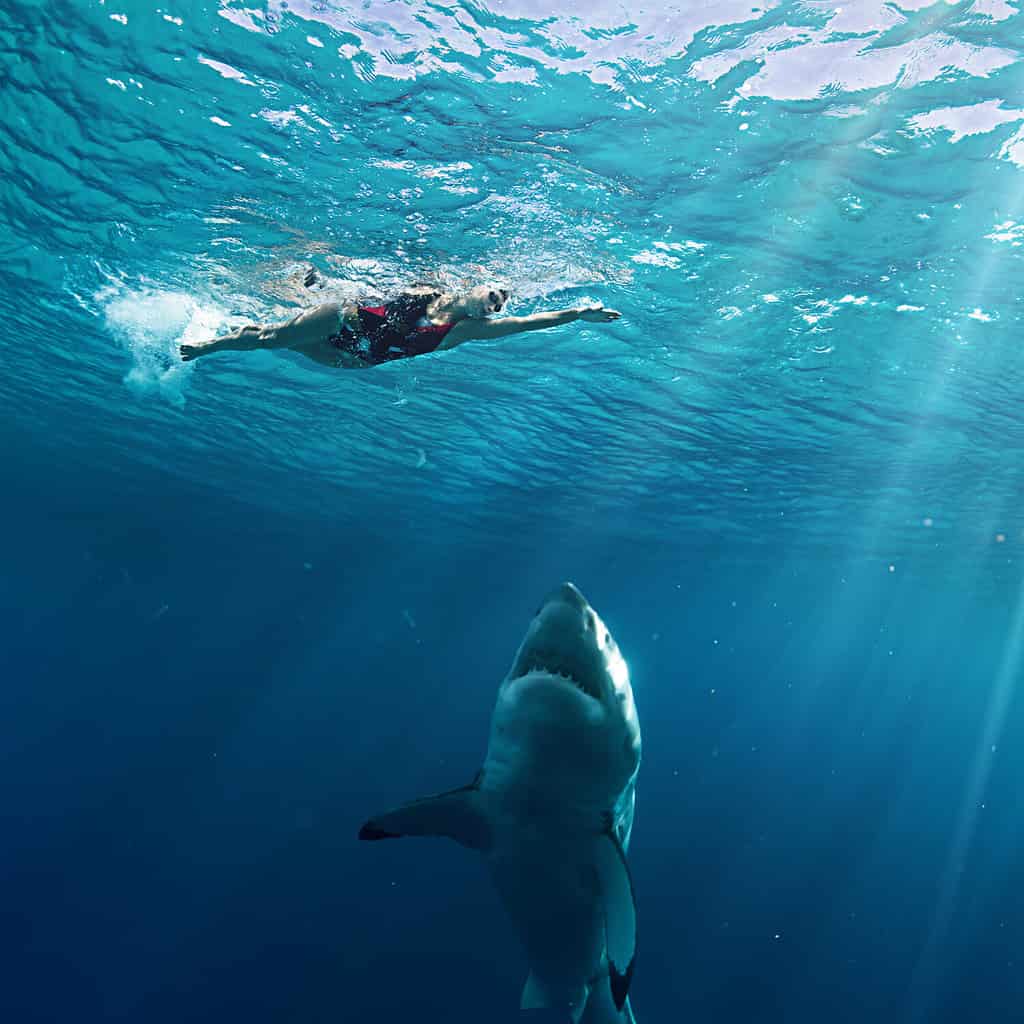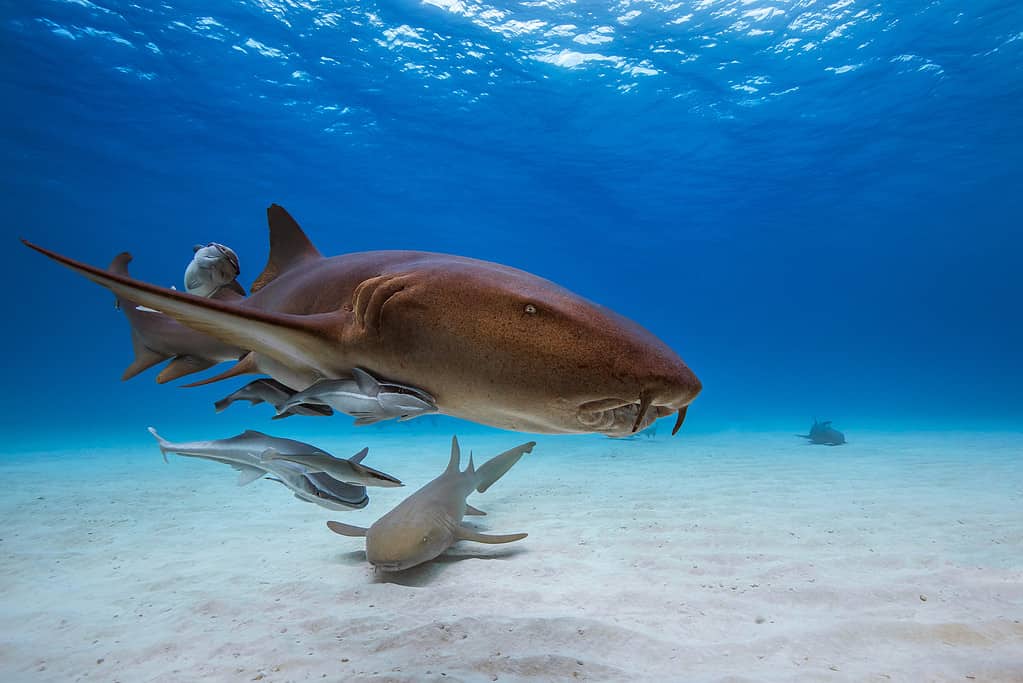Even if you don’t follow the news, you’ve surely taken note of the multitude of shark attacks happening recently. It seems like they are bloodthirsty for humans and won’t take no for an answer. It’s almost like a version of Jaws where it’s not one shark doing all the damage. Instead, it’s as if the sharks had an underwater meeting and have decided it’s their time to shine.
What’s going on with all these shark attacks? Have the toothsome fish finally had enough of us and are finding some creative ways to let us know? It might seem like it since the attacks haven’t been provoked. Let’s dig in a bit deeper and see what we know so far about the behaviors of sharks.
An Insight into Why Sharks Bite People

Whether the attacks are on purpose or not, sharks are large, frightening fish with rows of sharp teeth for eating meat.
©Willyam Bradberry/Shutterstock.com
There are many reasons why sharks might decide to attack a person. A vast amount of the time, it’s probably a mistake. Sharks do not enjoy the flavor of humans and would not purposely attack us to have a meal unless they were sick, injured, and starving to death. A healthy shark would have no problem finding fish, seals, and other meal choices, which would give them no reason to attack humans in the first place.
Below we will explore some of the reasons sharks attack people. A lot of the time, a curious shark will want to know what we are and if we are tasty, so they will use what they have to help determine that. Unfortunately for us, it’s their teeth that they use.
We can do a few things to cut down on opportunities by choosing to stay out of our homes; and the ocean. If that doesn’t sound reasonable, try sticking close to the shore, not wearing jewelry, not splashing, and always being aware of your surroundings. Do not swim near anglers or piers. Swimming with a friend is always important. If you are alone, try sticking near a group of people when you swim. Most attacks happen in water deeper than six feet.
Mistaken Identity

Each species of shark has specific prey that it hunts for, whether it be
jellyfish
, seals, large fish, or other sharks.
©Sergey Uryadnikov/Shutterstock.com
Sharks want to catch tasty fish, jellyfish, seals, and other delicious sea creatures. They do NOT want to grab a mouthful of human flesh. We taste so bad that they typically spit out the bite they take from a human or even go so far as to throw it up. There is a reason they bite us, they let go. Sometimes they might come back like they couldn’t believe how gross we tasted and wanted to give it one more shot before tossing in their fins for the day. Of course, one bite is generally all it takes to mortally injure a human.
Many attacks happen when a juvenile shark mistakenly grabs a human, thinking it’s something far more tasty. The juvenile sharks are inexperienced, just as juveniles of any species would be. They do things that an adult would know better than to do and take risks an adult likely wouldn’t take. Just like human teenagers, they make mistakes, which furthers their learning experience and helps shape them into decent members of society, or so we hope. The same can be said about juvenile sharks.
Juvenile Sharks Are Into Surfing
It is, however, fairly rare to be a victim of any shark attack but even more so, a juvenile attack. In the past several years, juvenile white sharks have been seen meandering along with surfers calmly and peacefully along the California coast, specifically San Onofre. They seem wary of the surfers, if anything, but do not seem especially frightened or aggressive. They are seen swimming along with surfers, paddleboarders, and kayakers, just as you would with a friend. Maybe only overly curious juvenile sharks take a bite.
Places along the CA coast, like San Onofre, are breeding grounds for great white sharks, and the juveniles stay put for several years. The meals are easy to come by since it’s a hot spot for whales “beaching” themselves underwater on the rocks. Sharks can’t pass up such an easy and free meal, and they choose to stick around because of it.
Most Bites Happen in Sand-Tumbled Waves

The water close to the shore, around tumbling waves breaking, is clouded with sand, and difficult to see anything at all.
©Jon Bilous/Shutterstock.com
Sharks have excellent eyesight in dim light, but it’s still very difficult to see underwater when you mix clouds of sand constantly swept up and tumbling from the sea floor into it. This probably accounts for most attacks on humans since 60% of attacks happen in wave-tumbled water near the shore. They may see an arm, fingers, leg, or toes and think they are seeing a fish. Once they bump into you to check you out, they might then realize you aren’t a fish, or they may try to grab the fish and mistakenly grab a leg instead.
Sharks are not sneaking up on you, they just can’t see what they are biting and have mistaken you for a fish. They also have a protective membrane, a bit like a translucent eyelid, which protects their eyes before they attack, so they aren’t seeing accurately at that moment. The shark is expecting to bite into a fish since they saw our hands, jewelry, feet, or nail polish reflect light. High-contrast colors may attract them, but the argument is still up in the air. Shiny, highly reflective jewelry won’t attract them, per se, but they will be drawn to check it out if they do see it. Leave your bling at the beach house when you swim in the ocean. Humans aren’t the only ones curious by nature.
Climate Change

The rising temperatures are not putting anyone in a very good mood.
©Guenter Albers/Shutterstock.com
With climate change driving ocean temperatures up and creating a complicated situation for all animals and humans, it isn’t hard to understand why everyone seems to be in a bad mood. At least humans can escape into some air conditioning. A lot of marine life is trying to find waters that are the temperature that their species needs to survive. Sharks, depending upon what type, do not like extremely warm water. They prefer water that is 50 – 80 degrees Fahrenheit.
There have been several great white attacks on Long Island beaches this summer. White sharks are swimming north to find cooler waters since the southern waters are considerably warmer than they have been in previous years. The Long Island beaches can be full this time of year, and the amount of people in the water with the white sharks is much higher than usual. More people combined with more sharks than usual is a recipe for disaster. Add in a whole spectrum of colored bathing suits, scented sunscreens, and wounds, and these poor sharks are just really confused. Sadly, it will only get worse as the sea level rises and warms. They will need to stay deep in the ocean or swim further north in the coming summers.
Pier Fishing

Sharks stick close to piers because of people fishing.
©Mike Whalen/Shutterstock.com
Most people have heard discussions about shark frenzied feeding and how dangerous it can be to swim near such an event. During a feeding frenzy, sharks become overly aggressive, trying to catch fish before other sharks do. A lot of the time, anglers dump their bait off the pier when they have finished fishing for the day. With bloodied fish, shrimp, and other bait floating in the water, it is the perfect combination to attract a shark.
Piers are also hot spots for people, with even more people swimming nearby. In this situation, sharks may have just left or are heading into a feeding frenzy when they swim near humans. They could mistake a person for a meal if there is bait and fish blood in the water. It’s a smart choice not to swim near piers.
Time of Day

Dawn and dust are when sharks are most actively feeding.
©Janelle Gibson/Shutterstock.com
It is best to swim in the daytime and avoid dawn and dusk. Those are the times sharks are the most actively feeding. They are in hunting mode so as not to miss feeding opportunities. These times of the day are when a shark is the most dangerous. Sharks are very good at seeing in dim light, so stay out of the water at sunset. Avoid wearing flashy jewelry if you can’t stay on shore.
When groups of fish are jumping out of the water, it’s likely because something is chasing them. Fish jump out of the water in varying directions to confuse predators. If you find yourself amidst jumping fish, it’s best to get out of there.
Defense

Nurse sharks
are docile sea giants that rarely turn aggressive.
©Carlos Grillo/ via Getty Images
There are times that sharks might become aggressive for a very simple reason, defense. Some sharks are bottom dwellers and spend their time sleeping during the day or scrounging around for crabs, jellyfish, and other small creatures. If you are in their area, you pose a threat to their food source. Especially when their food is scarce, these otherwise peaceful sharks might take offense to humans splashing around near their prey. In this case, they are at risk, just the same as if you put your hand in a starving dog’s dish while they are trying to eat.
Also, since some of the bottom dwellers have poor eyesight and sleep during the day, you might startle them and cause them to attack without knowing what it is they are attacking. Always let sleeping sharks lie, and always be on the lookout when you are walking in the shallow waters.
Anglers

Shark fishing is dangerous and can result in injury.
©Oleg Znamenskiy/Shutterstock.com
When humans choose to fish for large predatory sharks, they are taking a risk. They are also creating confusion in sharks that don’t know the difference between hunting prey and going after bait. When bait is in the water, it is always possible some of the chum may end up near shore. When a shark enters a feeding frenzy, it isn’t paying much attention to what it bites. It smells blood from the fish and loses its mind temporarily.
The angler is at risk when choosing to pull a shark aboard or onto the beach. A shark defending itself is going to use the only way it knows how, and that’s by using its teeth. It’s not so much that sharks hunt us because they don’t. We are a far bigger risk to them and DO actively hunt them. So who’s the real bad guy?
FAQ

Grey
Reef Shark
also known as a Grey Whaler Shark, Carcharhinus amblyrhynchos, swimming through a school of ox eye scad, Selar boops.
©cbpix/iStock via Getty Images
Q: Why are sharks curious about humans?
A: Sharks do not have parents who stick around and teach them life lessons. They must figure it all out on their own, and when a particularly curious shark ventures to further inspect a human, sometimes they bite. Similar to dogs, sharks must explore new things using their mouths since they do not have hands. Since their mouths are filled with razor-sharp teeth, this doesn’t always go so well in the human’s favor. After biting, they might lose interest and swim on the check out other things in the ocean, while the person would be left with a serious wound because of their curiosity.
Q: Why do sharks swim around you before attacking?
A: They are not circling before they attack, they are simply trying to figure out what you are from different angles. Since one lap around may not give them all of the information they need, they keep swimming around.
Q: Do most shark attacks happen in three feet of water?
A: Actually, no. Most shark attacks happen in 6 – 10 feet of water. Coming in second are attacks at 11 – 20 feet of water, and third place is 0 – 5 feet of water.
Q: What places have the most shark attacks?
The United States has the most attacks, followed by Australia. Brazil, South Africa, and the Bahamas also rank higher than other places in the world. In the US, Volusia, Florida, ranks the highest, with New Smyrna Beach winning the gold medal for most shark-related incidents. Coming in second place is another popular beach county, Brevard, Florida. Coco Beach is a popular spot for tourists and sharks.
Of course, Palm Beach follows in third place, making FL the leading state and place in the world for the most shark-related incidents. Coming after FL is Hawaii and SC. Hawaii is another very popular tourist destination, and with more people in the after comes more shark attacks. Myrtle Beach in SC is another popular beach and has many shark-related incidences yearly. As you can see, the more people in the water means more attacks will occur.
Q: Do sparkly things attract sharks?
A: It is believed that shiny jewelry, sparkly jewels, glittery nail polish, and other highly light reflective items attract sharks. They will not see such items from far away and come charging in, but they might come to inspect it and find out what you are. Many types of fish have iridescent, “glittery” scales that reflect light. Since sharks are great at seeing light reflections in dim ocean light, it’s best to remove all jewelry and sparkly objects before swimming in the ocean. Sharks aren’t the only thing hunting fish and are far from the only animals attracted to glittery objects. Barracudas are another fish highly attracted to shimmery jewelry.
The photo featured at the top of this post is © Lewis Burnett/Shutterstock.com
Thank you for reading! Have some feedback for us? Contact the AZ Animals editorial team.







